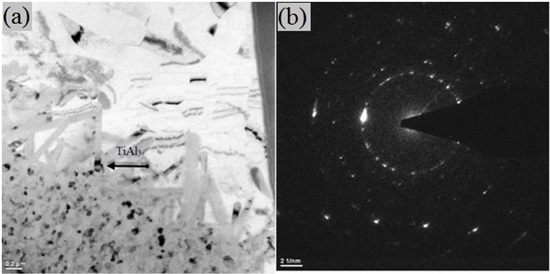Wear Behaviour of A356/TiAl3 in Situ Composites Produced by Mechanical Alloying
Abstract
:1. Introduction
2. Experimental Procedure
| Alloy | Si | Fe | Cu | Mn | Mg | Zn | Ti | Pb |
|---|---|---|---|---|---|---|---|---|
| A356 | 6.5 | 0.15 | 0.03 | 0.03 | 0.4 | 0.05 | 0.2 | 0.03 |
3. Results and Discussion
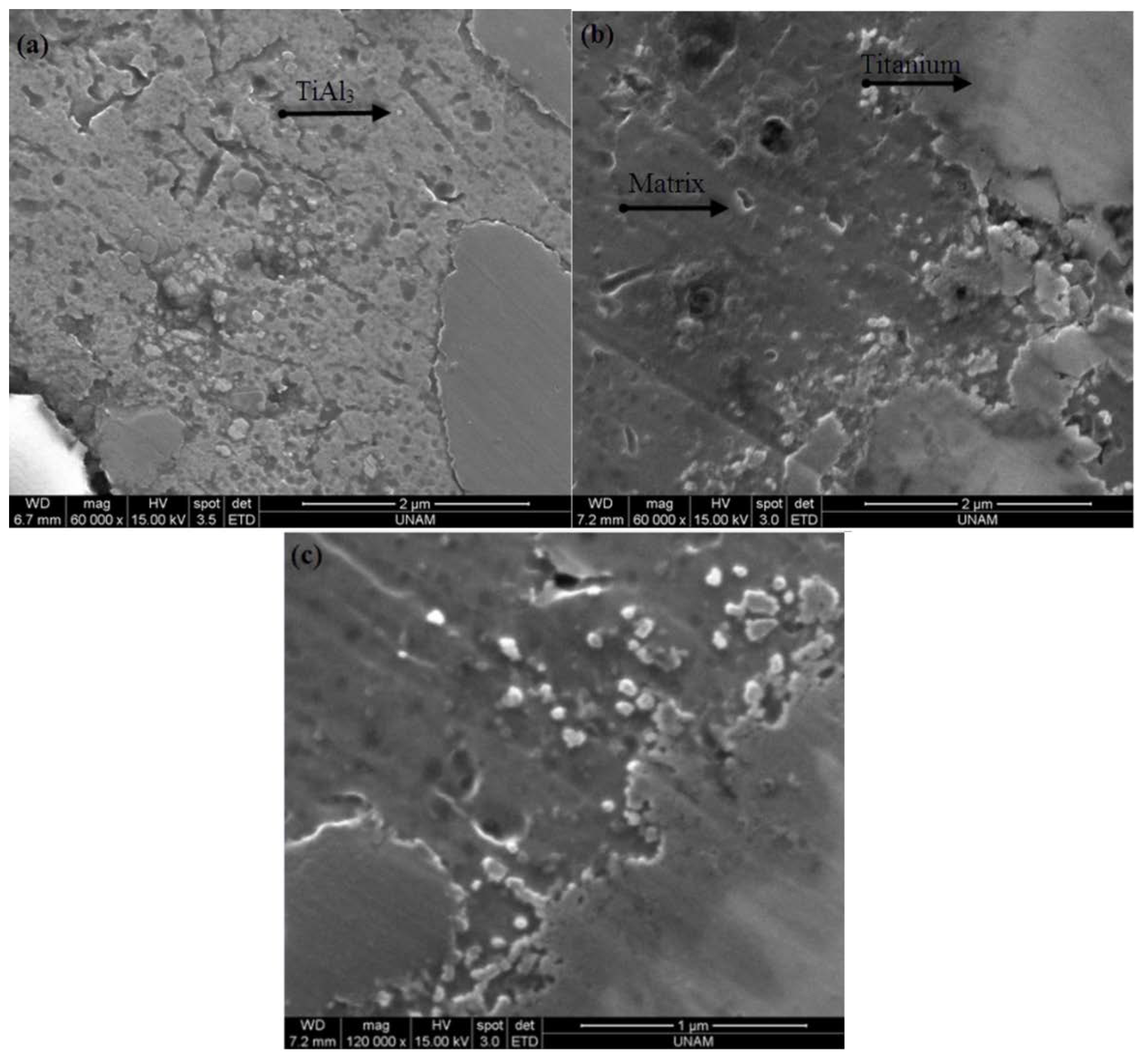
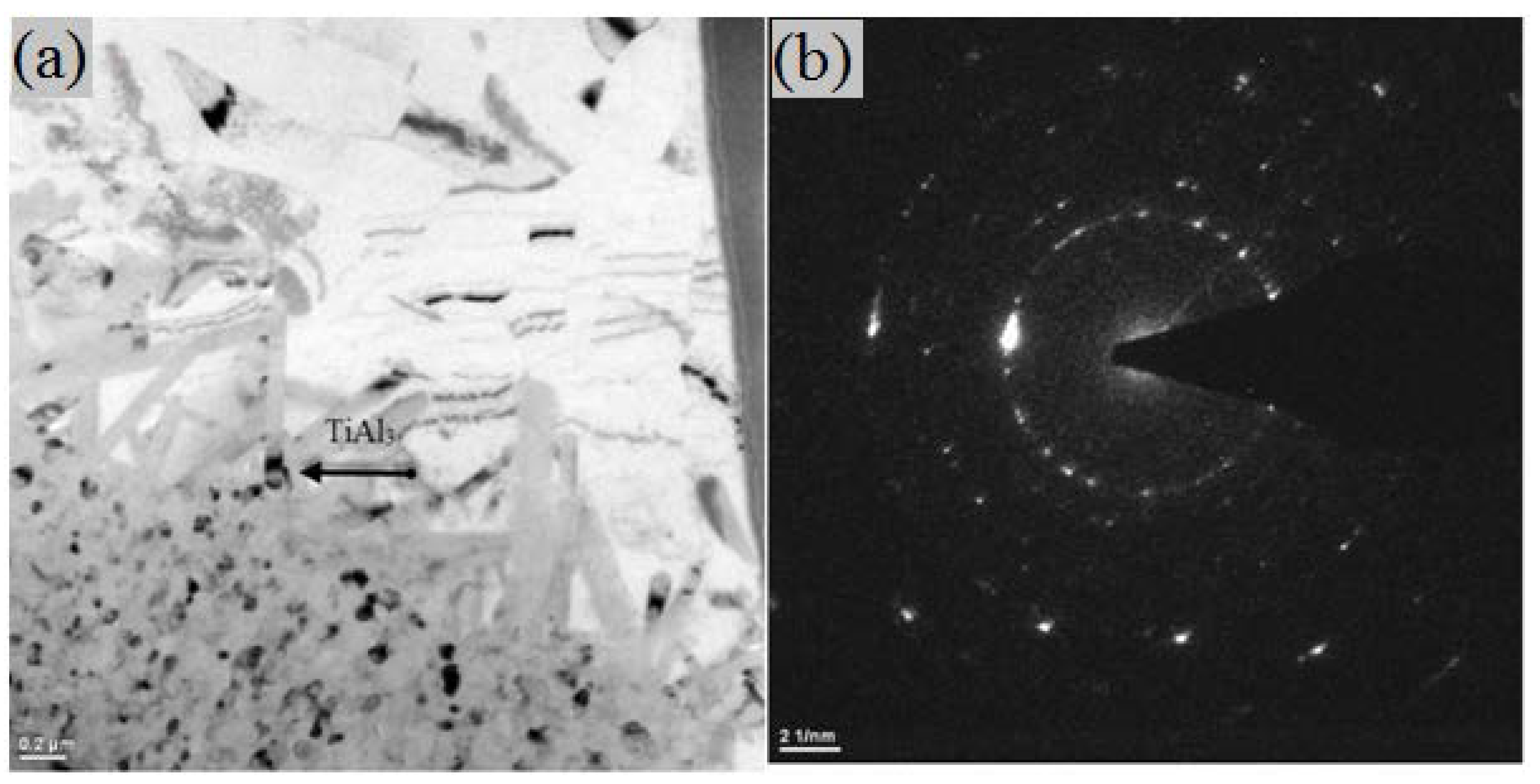


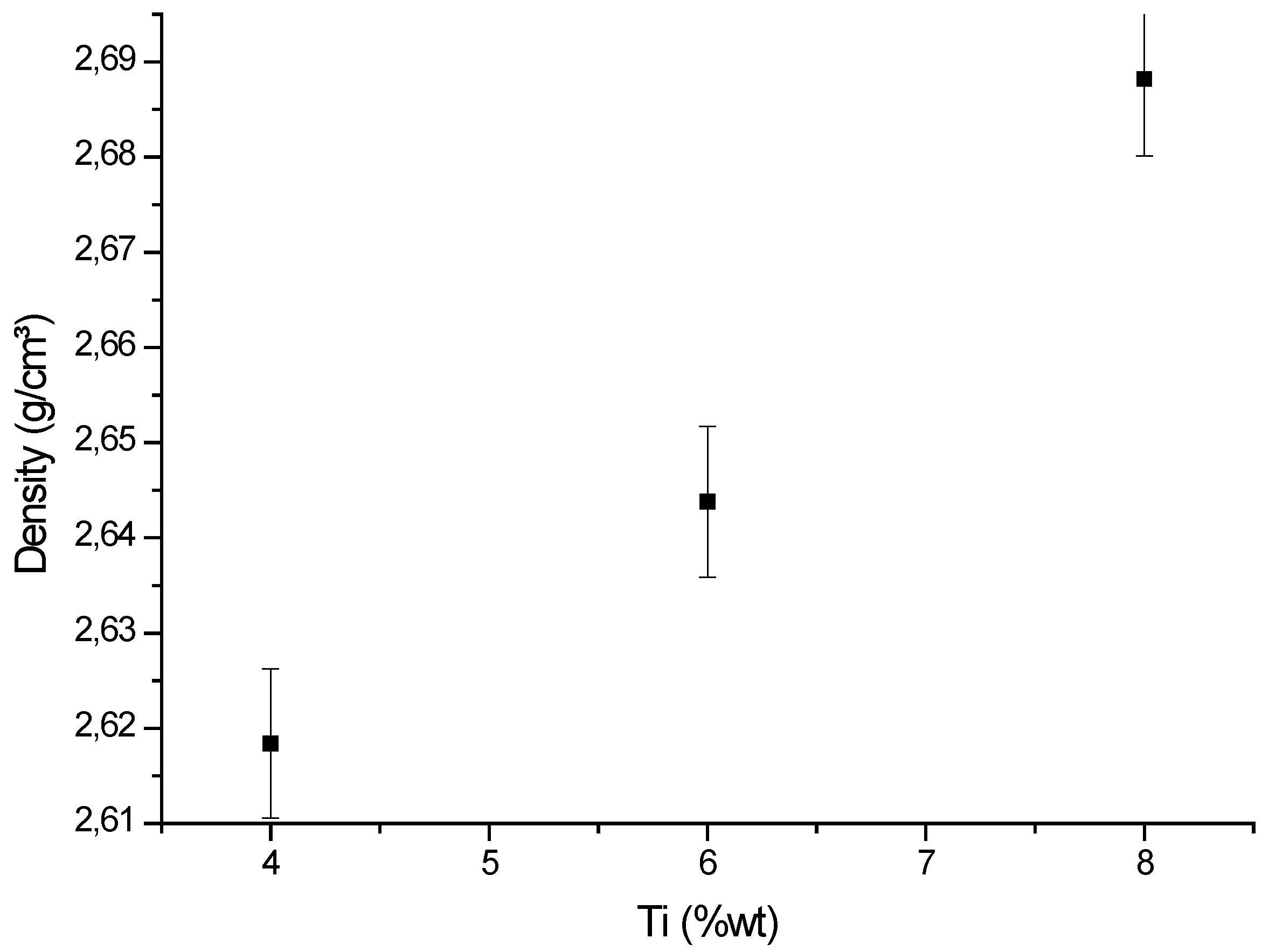
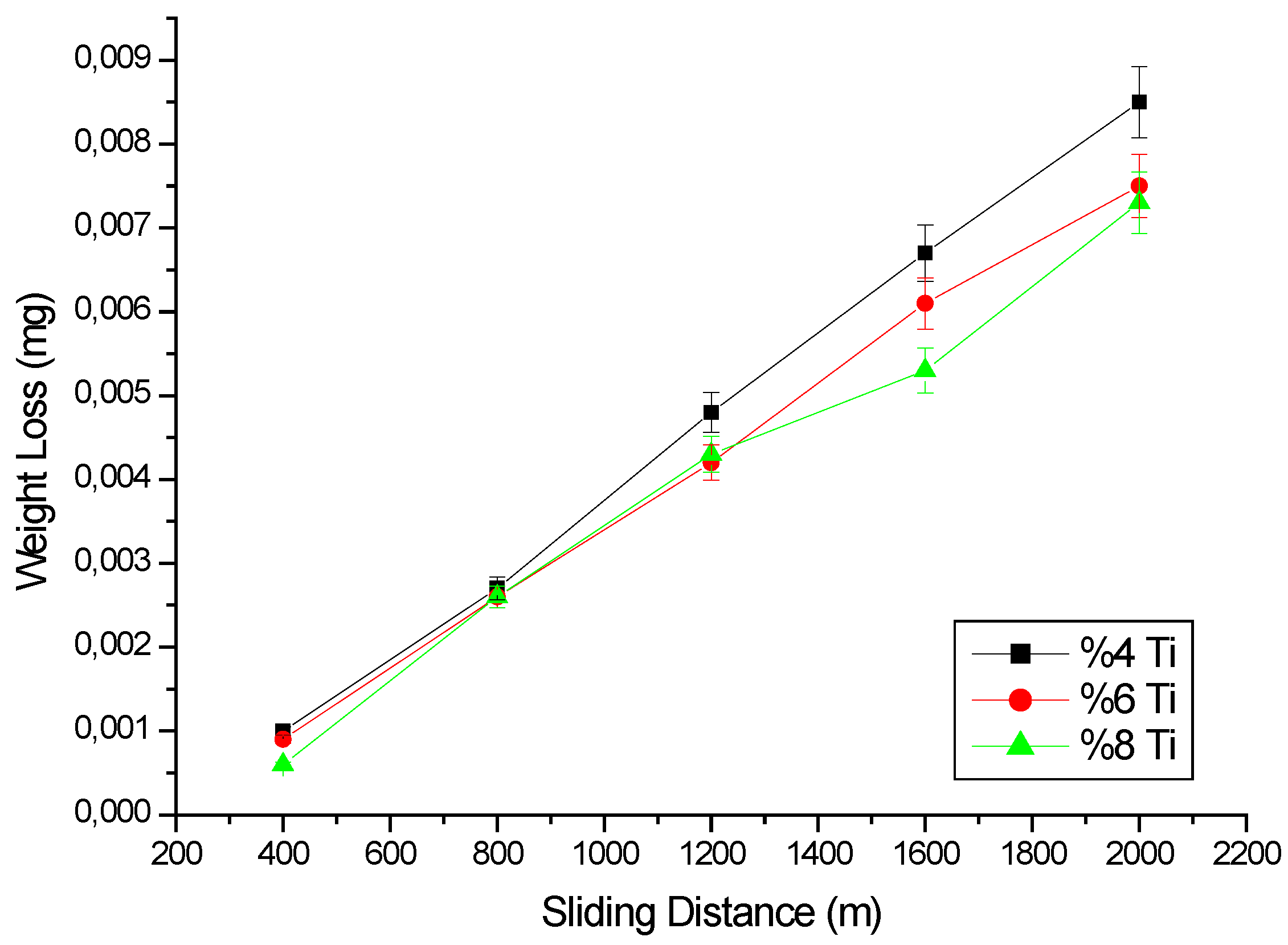
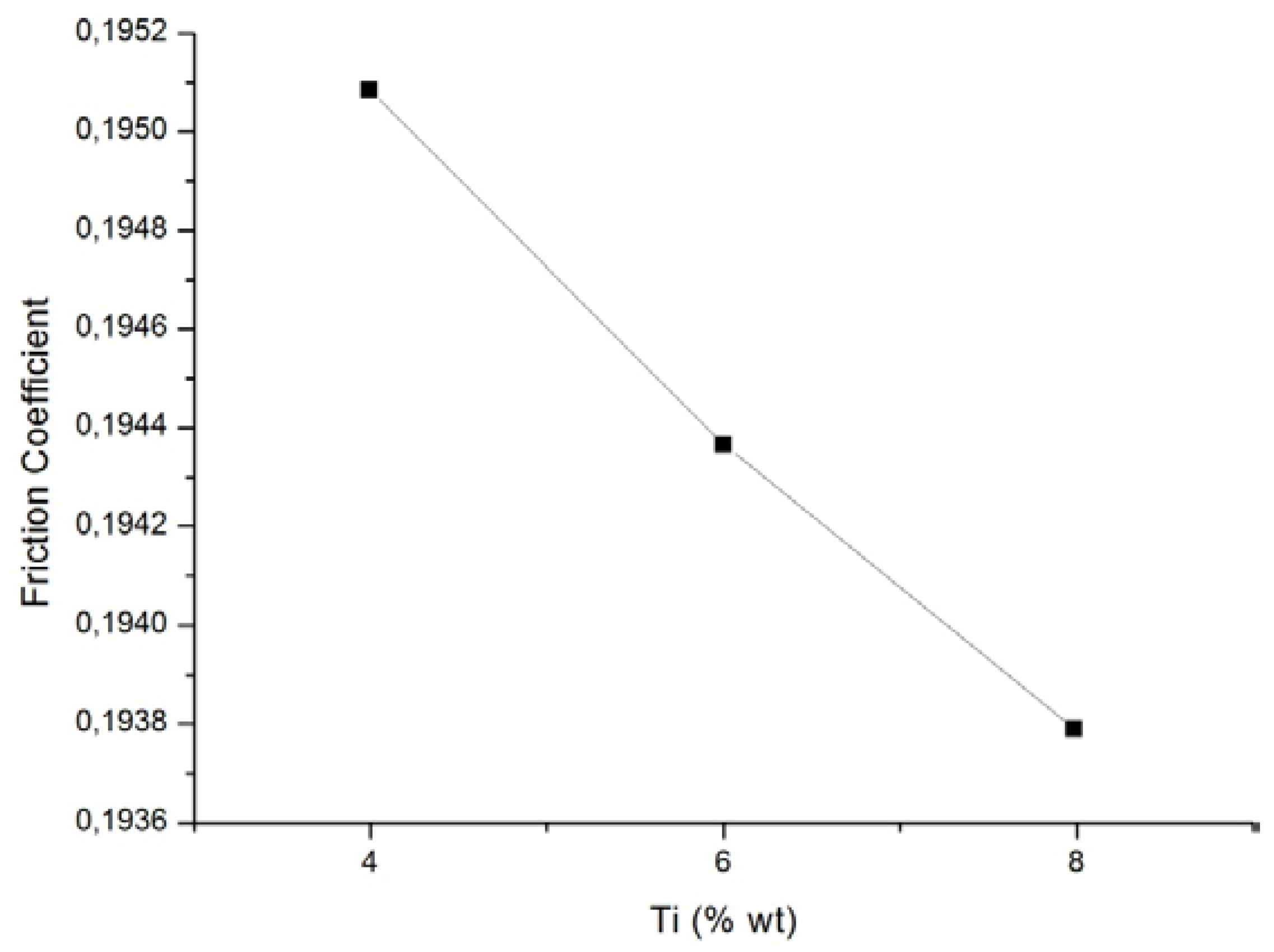

4. Conclusions
- As the amount of Ti in Al-Ti alloys increases, the hardness value increases.
- As the amount of added Ti increases in the composites, the density value also increases since the density of Ti is higher than that of Al.
- The XRD examinations show that the titanium aluminate phases (TiAl3 and AlTi), which increase strength in the samples, are formed in the alloy following the sintering process.
- The amount of intermetallic phases in the structure during sintering increases depending on the increasing titanium addition and that affects the wear properties.
- Sintered samples with higher percentages of titanium would exhibit less weight loss and a lower coefficient of friction.
Author Contributions
Conflicts of Interest
References
- Kumar, S.; Balasubramanian, V. Developing a mathematical model to evaluate wear rate of AA7075/SiCp powder metallurgy. Wear 1999, 264, 1026–1034. [Google Scholar] [CrossRef]
- Azadi, M.; Shirazabad, M.M. Heat treatment effect on thermo-mechanical fatigue and low cycle fatigue behaviors of A356.0 aluminum alloy. Mater. Des. 2013, 45, 279–285. [Google Scholar] [CrossRef]
- Ragab, K.A.; Samuel, A.M.; Al-Ahmari, A.M.A.; Samuel, F.H.; Doty, H.W. Influence of fluidized sand bed heat treatment on the performance of Al-Si cast alloys. Mater. Des. 2011, 32, 1177–1193. [Google Scholar] [CrossRef]
- Zhu, M.; Jian, Z.; Yang, G.; Zhou, Y. Effects of T6 heat treatment on the microstructure, tensile properties and fracture behavior of the modified A356 alloys. Mater. Des. 2012, 36, 243–249. [Google Scholar] [CrossRef]
- Kliauga, A.M.; Vieira, E.A.; Ferrante, M. The influence of impurity level and tin addition on the aging heat treatment of the 356 class alloy. Mater. Sci. Eng. A 2008, 480, 5–16. [Google Scholar] [CrossRef]
- Ahmed, S.; Haseeb, A.S.M.A.; Kurny, A.S.W. Study of wear behaviour of Al-4.5% Cu-3.4% Fe in situ composite: Effect of termal and mechanical processing. J. Mater. Process. Tech. 2007, 182, 327–332. [Google Scholar] [CrossRef]
- Niu, L.; Zhang, J.; Yang, X. In-situ synthesis of Al3Ti particles reinforced Al-Based composite coating. Trans. Nonferrous Met. Soc. China 2012, 22, 1387–1393. [Google Scholar] [CrossRef]
- Özyürek, D.; Tekeli, S.; Tuncay, T.; Yılmaz, R. The effect of synthesis time on the wear behavior of Al-8% Ti alloy produced by mechanical alloying. Powder Metall. Met. Ceram. 2012, 51, 491–495. [Google Scholar]
- Lu, L.; Lai, M.O.; Ng, C.W. Enhanced mechanical properties of an Al based metal matrix composite prepared using mechanical alloying. Mater. Sci. Eng. A 1998, 252, 203–211. [Google Scholar] [CrossRef]
- Hu, Q.; McColl, I.R.; Harris, S.J.; Waterhouse, R.B. The role of debris in the fretting wear of a SiC reinforced aluminium alloy matris composite. Wear 2000, 245, 10–21. [Google Scholar] [CrossRef]
- Zhao, N.; Nash, P.; Yang, X. The effect of mechanical alloying on SiC distribution and the properties of 6061 aluminum composite. J. Mater. Process. Tech. 2005, 170, 586–592. [Google Scholar] [CrossRef]
- Özyürek, D.; Tekeli, S. An investigation on wear resistance of SiCp-reinforced aluminium composites produced by mechanical alloying. Sci. Eng. Compos. Mater. 2010, 17, 31–38. [Google Scholar] [CrossRef]
- Aztekin, H.; Özyürek, D.; Çetinkaya, K. Production of hypo-eutectic Al-Si alloy based metal matrix composite with thixomoulding processing. High Temp. Mater. Process. 2010, 29, 169–178. [Google Scholar] [CrossRef]
- Walker, J.C.; Rainforth, W.M.; Jones, H. Lubricated sliding wear behaviour of aluminium alloy composites. Wear 2005, 259, 577–589. [Google Scholar] [CrossRef]
- Özyürek, D.; Tekeli, S.; Güral, A.; Meyveci, A.; Gürü, M. Effect of Al2O3 amount on microstructure and wear properties of Al-Al2O3 metal matrix composites prepared using mechanical alloying method. Powder Metall. Met. Ceram. 2010, 49, 289–294. [Google Scholar] [CrossRef]
- Daoud, A.; Reif, W. Influence of Al2O3 particulate on the aging response of A356 Al-based composites. J. Mater. Process. Tech. 2002, 123, 313–318. [Google Scholar] [CrossRef]
- Mandal, A.; Murty, B.S.; Chakraborty, M. Wear behaviour of near eutectic Al-Si alloy reinforced with in-situ TiB2 particles. Mater. Sci. Eng. A 2009, 506, 27–33. [Google Scholar] [CrossRef]
- Özyürek, D.; Ciftci, I. An investigation into wear behaviour of TiB2 particle reinforced aluminum composites produced by mechanical alloying. Sci. Eng. Compos. Mater. 2011, 18, 5–12. [Google Scholar] [CrossRef]
- Ruiz-Navas, E.M.; Fogognolo, J.B.; Valesco, J.B.; Ruiz-Prieto, J.M.; Froyen, L. One step production of aluminium matrix composite powders by mechanical alloying. Compos. A Appl. Sci. Manuf. 2006, 37, 2114–2120. [Google Scholar] [CrossRef]
- Clemens, H.; Wallgram, W.; Kremmer, S.; Ther, V.G.; Otto, A.; Bartels, A. Design of novel β-solidifying TiAl alloys with adjustable β/B2-phase fraction and excellent hot-workability. Adv. Eng. Mater. 2008, 10, 707–713. [Google Scholar] [CrossRef]
- Tetsui, T.; Shindo, K.; Kaji, S.; Kobayashi, S.; Takeyama, M. Fabrication of TiAl components by means of hot forging and machining. Intermetallics 2005, 13, 971–978. [Google Scholar] [CrossRef]
- Hsu, C.J.; Chang, C.Y.; Kao, P.W.; Ho, N.J.; Chang, C.P. Al-Al3Ti nonocomposites produced in-situ by friction stir processing. Acta Mater. 2006, 54, 5241–5249. [Google Scholar] [CrossRef]
- Yeh, C.L.; Su, S.H. In situ formation of TiAl-TiB2 composite by SHS. J. Alloy. Compd. 2006, 407, 150–156. [Google Scholar] [CrossRef]
- Liu, Y.; Xiu, Z.; Wu, G.; Jiang, L.; Gou, H.; Jiang, G. Microstructure evolution of Ti-Al-C system composite. Rare Met. Mater. Eng. 2010, 39, 1152–1156. [Google Scholar]
- Shi, T.; Zhang, J.; Wang, L.; Jiang, W.; Chen, L. Fabrication, microstructure and mechanical properties of TiC/Ti2AlC/TiAl3 in situ composite. J. Mater. Process. Tech. 2011, 27, 239–244. [Google Scholar]
- Wang, T.; Zhang, J. Thermoanalytical and metallographical investigations on the synthesis of TiAl3 from elemantary powders. Mater. Chem. Phys. 2006, 99, 20–25. [Google Scholar] [CrossRef]
- Prakash, U.; Sauthoff, G. Structure and properties of Fe-Al-Ti intermetallic alloys. Intermetallics 2001, 9, 107–112. [Google Scholar] [CrossRef]
- Özyürek, D.; Tunçay, T.; Evlen, H.; Çiftçi, I. Synthesis, Characterization and Dry Sliding Wear Behavior of In-situ Formed TiAl3 Precipitate Reinforced A356 Alloy Produced by Mechanical Alloying Method. Mater. Res. 2015, 18, 813–820. [Google Scholar]
- Rafiei, M.; Khademzadeh, S.; Parvin, N. Characterization and formation mechanism of nanocrystalline W-Al alloy prepared by mechanical alloying. J. Alloy. Compd. 2010, 489, 224–227. [Google Scholar] [CrossRef]
- Tang, H.; Cheng, Z.; Liu, J.; Ma, X. Preparation of a high strength Al-Cu-Mg alloy by mechanical alloying and press-forming. Mater. Sci. Eng. A 2012, 550, 51–54. [Google Scholar] [CrossRef]
- Gu, D.; Zhang, G.; Dai, D.; Wang, H.; Shen, Y. Nanocrystalline tungsten-nickel heavy alloy reinforced by in-situ tungsten carbide: Mechanical alloying preparation and microstructural evolution. Int. J. Refract. Met. Hard Mater. 2013, 37, 45–51. [Google Scholar] [CrossRef]
- Yu, P.; Zhang, L.C.; Zhang, W.Y.; Das, J.; Kim, K.B.; Eckert, J. Interfacial reaction during the fabrication of Ni60Nb40 metallic glass particles-reinforced Al based MMCs. Mater. Sci. Eng. A 2007, 444, 206–213. [Google Scholar] [CrossRef]
- Chianeh, V.A.; Hossein, H.R.; Nofar, M. Microstructural features and mechanical properties of Al-Al3Ti composite fabricated by in-situ powder metallurgy route. J. Alloy. Compd. 2009, 473, 127–132. [Google Scholar] [CrossRef]
- Rao, A.K.P.; Das, K.; Murty, B.S.; Chakraborty, M. Microstructural and wear behavior of hypoeutectic Al-Si alloy (LM25) grain refined and modified with Al-Ti-C-Sr master alloy. Wear 2006, 261, 133–139. [Google Scholar]
- Mishin, Y.; Herzig, C. Diffusion in the Ti-Al system. Acta Mater. 2000, 48, 589–623. [Google Scholar] [CrossRef]
- Vencl, A.; Rac, A.; Bobic, I.; Miskovic, Z. Tribological properties of Al-Si alloy reinforced with Al2O3 particles. Tribol. Ind. 2006, 28, 27–31. [Google Scholar]
- Sağlam, I.; Özyürek, D.; Çetinkaya, K. Effect of ageing treatment on wear properties and electrical conductivity of Cu-Cr-Zr alloy. Bull. Mater. Sci. 2011, 34, 1465–1470. [Google Scholar] [CrossRef]
- Attar, H.; Prashanth, K.G.; Chaubey, A.K.; Calin, M.; Zhang, L.C.; Scudino, S.; Eckert, J. Comparison of wear properties of commercially pure titanium prepared by selective laser melting and casting processes. Mater. Lett. 2015, 142, 38–41. [Google Scholar] [CrossRef]
© 2016 by the authors; licensee MDPI, Basel, Switzerland. This article is an open access article distributed under the terms and conditions of the Creative Commons by Attribution (CC-BY) license (http://creativecommons.org/licenses/by/4.0/).
Share and Cite
Çam, S.; Demir, V.; Özyürek, D. Wear Behaviour of A356/TiAl3 in Situ Composites Produced by Mechanical Alloying. Metals 2016, 6, 34. https://doi.org/10.3390/met6020034
Çam S, Demir V, Özyürek D. Wear Behaviour of A356/TiAl3 in Situ Composites Produced by Mechanical Alloying. Metals. 2016; 6(2):34. https://doi.org/10.3390/met6020034
Chicago/Turabian StyleÇam, Seda, Vedat Demir, and Dursun Özyürek. 2016. "Wear Behaviour of A356/TiAl3 in Situ Composites Produced by Mechanical Alloying" Metals 6, no. 2: 34. https://doi.org/10.3390/met6020034
APA StyleÇam, S., Demir, V., & Özyürek, D. (2016). Wear Behaviour of A356/TiAl3 in Situ Composites Produced by Mechanical Alloying. Metals, 6(2), 34. https://doi.org/10.3390/met6020034




